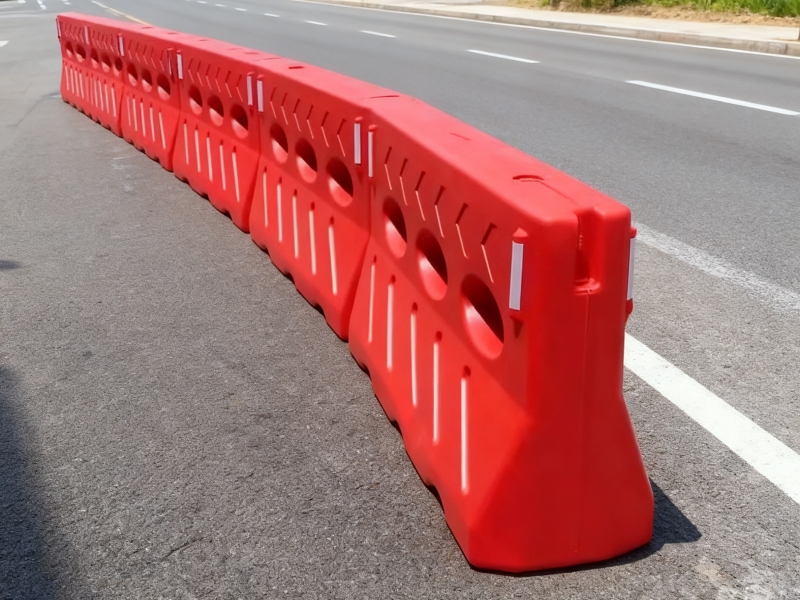Based on the production process, water barriers can be divided into two categories: rotomolded water barriers and blow-molded water barriers. In terms of style, water barriers can be further divided into five categories: isolation pier water barriers, two-hole water barriers, three-hole water barriers, fence water barriers, high fence water barriers, and crash barrier water barriers. Based on the production process and style, water barriers can be mainly divided into rotomolded water barriers and blow-molded water barriers, and their respective styles vary.
Differences between Rotomolding and Blow Molding Water Filled Barriers
Rotomolded water barriers are made using a rotomolding process and are made from virgin imported polyethylene (PE) plastic. They feature vibrant colors and durability. Blow-molded water barriers, on the other hand, use a different process. Both are collectively referred to as plastic water barriers for transportation facilities and are available on the market.
Raw Material Differences: Rotomolded water barriers are made entirely of 100% virgin imported PE material, while blow-molded water barriers use a mixture of plastic regrind, waste, and recycled materials. Appearance and Color: Roto-molded water barriers are beautiful, uniquely shaped, and vibrantly colored, offering a vibrant visual effect and excellent reflective properties. In contrast, blow-molded water barriers are duller in color, less visually appealing, and offer suboptimal nighttime reflectivity.
Weight Difference: Roto-molded water barriers are significantly heavier than blow-molded ones, weighing over one-third more. When purchasing, consider product weight and quality.
Wall Thickness Difference: The inner wall thickness of roto-molded water barriers is typically between 4-5mm, while that of blow-molded ones is only 2-3mm. This not only affects the weight and raw material cost of blow-molded water barriers, but more importantly, reduces their impact resistance.
Service Life: Under similar natural conditions, roto-molded water barriers typically last over three years, while blow-molded ones may only last three to five months before deformation, breakage, or leakage develop. Therefore, from a long-term perspective, roto-molded water barriers offer a higher cost-effectiveness.
Roto-molding is also known as rotational molding or rotational casting. Rotomolding is a method for hollow-molding thermoplastics. A powdered or pasty material is injected into a mold. The mold is heated and rotated vertically and horizontally, allowing the material to evenly fill the mold cavity and melt due to gravity and centrifugal force. After cooling, the product is demolded to form a hollow part. Because the rotational speed of rotomolding is low, the product is virtually stress-free and less susceptible to deformation, dents, and other defects. The product surface is flat, smooth, and vibrantly colored.
Blow molding is a method for producing hollow thermoplastic parts. The blow molding process consists of five steps: 1. Extruding a plastic preform (a hollow plastic tube); 2. Closing the mold flaps over the preform, clamping the mold, and cutting the preform; 3. Inflating the preform against the cold wall of the mold cavity, adjusting the opening and maintaining pressure during cooling; opening the mold and removing the blown part; 5. Trimming the flash to produce the finished product. A wide variety of thermoplastics are used in blow molding. Raw materials are tailored to meet the functional and performance requirements of the blow-molded product. Blow-molding-grade raw materials are plentiful, with polyethylene, polypropylene, polyvinyl chloride, and thermoplastic polyester being the most commonly used. Recycled, scrap, or regrind can also be blended.
Water Barrier Technical Parameters
Filled Weight: 250kg/500kg
Tensile Strength: 16.445MPa
Impact Strength: 20kJ/cm²
Elongation at Break: 264%
Installation and Usage Instructions
1. Made from imported, environmentally friendly linear polyethylene (PE), it is durable and recyclable.
2. Attractive, fade-resistant, and easily used together, it provides a high warning signal and reduces the risk of accidents.
3. Bright colors provide clear route indication and enhance the beautification of roads or cities.
4. Hollow and water-filled, they provide cushioning properties, effectively absorbing strong impacts and significantly reducing damage to vehicles and personnel.
5. Serialized for robust overall support and stable installation.
6. Convenient and quick: two people can install and remove, eliminating the need for a crane, saving transportation costs.
7. Used for diversion and protection in crowded areas, reducing police presence.
8. Protects road surfaces without requiring any road construction.
9. Can be positioned in straight or curved lines for flexibility and convenience.
10. Suitable for use on any road, at intersections, toll booths, construction projects, and in areas where large or small crowds gather, effectively dividing roads.
Post time: Sep-30-2025







